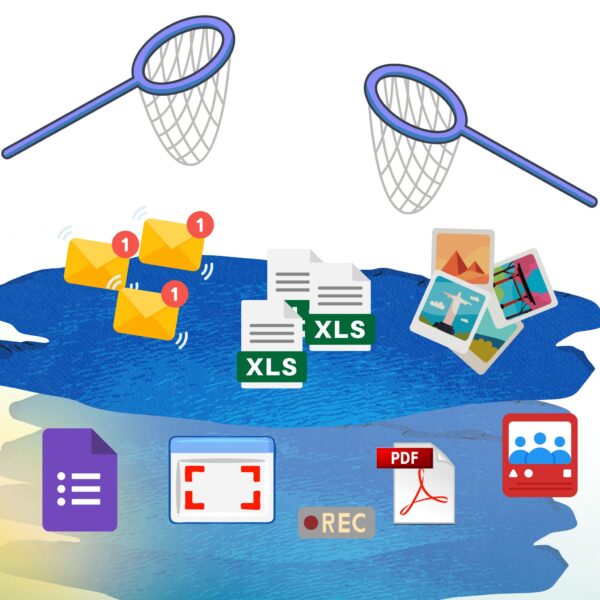With the growing adoption of AI, the way businesses manage unstructured data has changed. The Association for Intelligent Information Management (AIIM) found that 90% of organizations expect AI to impact how they work with unstructured file formats. AI-powered platforms can retrieve, capture, and analyze data at scale and with high precision, speeding up decision-making.
A super simple example of AI changing the game; is the tool Aurora Slides. It can process your meeting transcripts. notes, and prompts, and turn it into a structured deck you can later tag and reference.
But here’s the thing—many of us feel absolutely buried by digital clutter, not just in business but in everyday life. As one user on Reddit’s r/minimalism put it:
Does anyone else feel completely overwhelmed by digital clutter?
byu/tidy-mindset inminimalism
If you picture the modern workplace, you’ll see it’s overflowing with emails, PDFs, scattered powerphotos, voice memos, and a wild mix of digital clutter that defies simple organization. For anyone interested in AI, machine learning, or even just running a business today, understanding raw data isn’t optional. It’s essential.
Before we dive into how AI is changing the game, let’s get clear on what unstructured data actually is—and why it’s so powerful (and tricky) to work with. If you want to jump directly into adoption I recommend you check out our Mastering AI Adoption Guide.
What is Unstructured Data? (Types, and Examples)
Messy information is information that doesn’t fit neatly into rows and columns or follow a formal specific format. Think of it as the digital “stuff” that surrounds us every day: emails, PDFs, images, videos, audio files, social media posts, even sensor data from IoT devices. Unlike structured data (which has a predefined data model), unformatted data does not easily conform to the fixed schemas of conventional databases. Instead, it’s often stored in file systems, non-relational (NoSQL databases), or massive data lakes.

Analogy:
Imagine unstructured data as a vast, murky lake. On the surface, you might glimpse a few familiar objects—an email here, a photo there. But beneath the surface, countless unidentified items drift by: some are valuable, some are just junk, and many are invisible to the naked eye. For years, businesses treated this “dark data” as unfishable—too deep, too unclear, too overwhelming to explore. Only with new AI-powered sonar, LLMs, and nets can we begin to see, identify, and retrieve what’s truly valuable from the depths.
Here’s a more comprehensive table to break down the spectrum of data types you’ll encounter:
| Data Type / System | Structured? | Typical Format/Source | Storage/System Type | Example Use Case |
|---|---|---|---|---|
| Excel files | Yes | .xlsx, .csv | Spreadsheet, Local/Cloud | Financial modeling, reporting |
| SQL databases | Yes | SQL | RDBMS | Customer records, transactions |
| Point-of-sale data | Yes | Tabular, CSV | Inventory, Sales System | Sales tracking, inventory management |
| Web form results | Yes | HTML/CSV, DB | CRM, Marketing DB | Lead capture, survey responses |
| SEO tags | Yes | HTML/XML | CMS, Web Platform | Search engine optimization |
| Product directories | Yes | Tabular, CSV | E-commerce DB | Product listings, catalogs |
| Inventory control | Yes | Spreadsheet/DB | ERP, Inventory DB | Stock management, order fulfillment |
| Reservation systems | Yes | DB, CSV | Booking platform | Travel, hospitality bookings |
| Transaction Records | Yes | CSV, TSV | RDBMS | Sales analytics |
| Customer Database | Yes | SQL, Excel | RDBMS, Data Warehouse | CRM, BI dashboard |
| Sensor Logs | Semi | JSON, XML | Data Lake, NoSQL, Cloud Storage | IoT monitoring |
| Semi/No | .eml, Gmail, Outlook | File System, Cloud Email | Customer support | |
| Social Media Post | No | Twitter, Reddit | Data Lake, NoSQL | Brand monitoring |
| X-Ray Image | No | .dcm, .png, .jpeg | File System, PACS | Medical diagnostics |
| Sales Invoice PDF | No | .pdf, .tiff | File System, Cloud Drive | Accounting, auditing |
| Meeting Recording | No | .mp4, .wav | File System, Cloud Storage | Training, compliance |
| Chat Logs | No | Slack, Teams Export | Data Lake, NoSQL | Employee insights |
| Handwritten Note Scan | No | .jpg, .pdf | File System, Cloud Drive | Research, documentation |
| Website Screenshot | No | .png, .jpeg | File System, CMS | Marketing analysis |
And in the real world, this “lake” of unsorted, drifting information leads to confusion and missed opportunities. As businesses build bigger data lakes, without the right tools, they risk simply accumulating more “dark data”—information that’s stored, but never seen, understood, or turned into value.
Understanding the types and formats of rambling information is the first step to learning how to “fish” for insights, rather than letting valuable knowledge sink and disappear.
Structured, Semi-Structured, and Unstructured Data
Not all data falls at the extremes of “totally organized” or “utter chaos.” There’s a spectrum, and knowing where your data lands is the first step to managing it.
At one end is structured data—think SQL databases or Excel files, where every field is defined and every record fits into a neat row and column. At the other end is raw data: raw text, images, videos, and audio that have no predefined format.
Semi-structured data acts as a bridge between these two worlds. According to IBM, semi-structured data doesn’t follow a rigid data model, but it uses metadata—tags or semantic markers—to organize information. This metadata enables semi-structured data to be better cataloged, searched, and analyzed than purely raw data.
Why does this matter? Because the more structure you can add (even just metadata), the easier it is to search, analyze, and use your data—especially when AI enters the picture.
Real-world examples:
- Meta tags on web pages: While a blog post’s content is unstructured text, the meta tags (title, description, keywords) are structured markers that help search engines and analytics tools organize and retrieve information more efficiently.
- Emails: The “From,” “To,” and “Subject” headers are structured, but the body is open-ended text—making the whole email semi-structured.
- JSON, CSV, XML files: These formats add structure through tags and keys, but the values can be free-form text or mixed types.
- NoSQL databases: Useful for web scraping and data integration, these often store semi-structured data to flexibly capture information that doesn’t fit traditional schemas.
In summary: semi-structured data is the connective tissue that lets us bring order to digital chaos, making it a vital part of modern data strategies—especially in environments where web content, cloud platforms, and analytics all collide.

Why Does Unstructured Data Matter?
So, why bother with this messy attic at all? Because the attic is huge. Up to 90% of all enterprise data is unstructured, and it’s growing at a staggering rate of 55-65% per year. That’s an overwhelming amount of information—most of which is invisible to traditional analytics tools.
When you unlock it, you get:
- A holistic view of the customer (sentiment from social, support, etc.)
- Enhanced decision-making (context and nuance that dashboards miss)
- Innovation and personalization powered by AI
Of course, it’s not just opportunity—there’s also frustration and lack of resources. As one Reddit user vented:
Comment
byu/chrisgarzon19 from discussion
indataengineering
Let’s see how AI can help and how you can get started…
How AI Makes Sense of Unstructured Data
Traditional tools break down when faced with a wall of PDFs, images, or natural language text. That’s where AI steps in. Algorithms (with the help of humans) can scan, tag, and extract meaning from chaos.
Here’s where AI shines:
- Retail: Sentiment analysis of reviews and chat logs
- Healthcare: Diagnostics from MRI scans and messy physician notes
- Finance: Fraud detection in claims and voice calls
- Legal: Contract review and risk analysis in massive document troves
| Industry | Unstructured Data Source | AI Use Case |
|---|---|---|
| Retail | Reviews, Chat Logs | Sentiment Analysis |
| Healthcare | MRI, Physician Notes | Diagnostics, Disease Tracking |
| Finance | Claims, Voice Calls | Fraud Detection, Compliance Checks |
| Legal | Contracts, Emails | Clause Extraction, Risk Review |
But don’t take AI’s magic for granted but also do not overestimate it to do all the work on its own. On Reddit, a user shared:
Comment
byu/PostponeIdiocracy from discussion
indatascience
To which another Reddit user replied:
Comment
byu/PostponeIdiocracy from discussion
indatascience
Success depends on how you prepare and manage your data, resources, and learning which types of raw information can be used with AI realistically—let’s explore that next.
How to Prepare Unstructured Data for AI
Getting value from rambling data isn’t automatic. In fact, recent research highlights just how critical (and challenging) this step is. According to the AI Data Readiness Research Report by Huble:
- 69% of companies say poor data limits their ability to make informed decisions.
- 45% report that unstructured, fragmented data is the single biggest barrier to AI success.
- Only 8.6% of companies are fully AI-ready.
The issue isn’t the AI itself—it’s the weak, disorganized data foundations beneath it. Organizations are moving forward with AI-driven decision-making, but they’re building on fragmented systems, inconsistent data, and poor governance. Instead of using AI’s full potential, many are finding that bad data leads to unreliable insights, flawed automation, and costly inefficiencies.
So, how do you actually get unstructured data ready for AI—especially as GenAI adoption accelerates?
Drawing from the Youtube video “Top 10 Considerations for Safely Using Unstructured Data with GenAI”, here’s a modern, actionable playbook:
- Automate Data Discovery:
Instantly locate files across cloud and on-prem environments. Use discovery tools to find out where your data lives and whether it’s properly secured or encrypted. - Classify and Catalog Data with AI/ML:
Leverage machine learning to classify files by sensitivity, topic, or type. Build a rich data catalog with contextual metadata. - Extract and Curate Across Formats:
Ensure your tools can parse and extract from Word, PowerPoint, Excel, HTML, PDF, and multimedia files, then curate and label the most relevant data for AI use. - Sanitize for Privacy:
Redact or mask PII and sensitive info before using data in AI projects to reduce privacy and compliance risks. - Preserve Access Controls:
Maintain original permissions and entitlements as data moves into AI workflows—so only the right people have access. - Track Data Lineage:
Build visibility from your source systems through vector databases, LLMs, and endpoints. This enables robust governance and auditability. - Monitor Data Quality:
Focus on freshness, deduplication, and topic relevance—classic “accuracy” metrics don’t always apply to unformatted dat. - Implement AI-Specific Security:
Use policies and firewalls to prevent prompt injection, data leaks, and malicious use in GenAI environments.
“Unstructured data often contains sensitive information and, if exposed, can lead to governance, privacy, and security risks that traditional data management tools aren’t equipped to handle.”
— Top 10 Considerations for Safely Using Unstructured Data with GenAI
Watch the full video here:
By combining rigorous data hygiene (as highlighted by the Huble report) with GenAI-specific safeguards and automation, you can transform your messy data from a liability into a true competitive advantage.
Now let’s see how these principles come to life in a real-world product that works with some forms of unstructured data.
Product Spotlight: Aurora Slides
Imagine this: You’re part of a busy team preparing for a high-stakes presentation or the best investment deck your company has ever produced. Instead of wrestling with scattered PDFs, photos, handwritten notes, and email threads, you drop them all into Aurora Slides. Instantly, the platform pulls together your unstructured content, using advanced NLP to summarize, extract, and visualize the key points that matter most. What used to take hours or even days—painstakingly sifting through digital clutter—is now accomplished in minutes.
Here’s how a scenario could play out with Aurora Slides:
- You upload a mix of project reports, whiteboard snapshots, and voice memos.
- Aurora Slides automatically recognizes and organizes these formats, extracting important data and action items.
- The AI generates a polished slide deck, highlighting insights, trends, and recommendations—ready to share with your team or clients.
- Productivity soars, whether you’re in business, education, or research.
An AI Deck Builder like Aurora Slides is closing the gap between unstructured chaos and polished insights is closing fast—empowering teams to turn information overload into a strategic advantage.

Conclusion
Unstructured data is the new “oil”—worthless unless refined, but transformative when tapped by AI. Don’t leave your attic a mess. Start with a data inventory, look for AI-powered tools, and you might be surprised by the business gold you uncover.
If you’re ready to dig deeper, check out guides on data strategy, AI solutions, and how Aurora Slides can help your team work smarter. Quick reading recommendation – Top 10 AI for Teams.
Frequently Asked Questions (FAQs)
What are the main types of unstructured documentation?
A: Anything that isn’t neatly organized in a database—emails, images, audio, PDFs, social posts, and more.
How does AI read or analyze rambling data?
A: Through techniques like NLP (for text), computer vision (for images), and machine learning models trained to recognize patterns.
Which industries benefit the most?
A: Every industry—retail, healthcare, finance, law, and more—because unstructured data is everywhere.
What’s the difference between structured and unorganized data?
A: Structured data fits in tables (think Excel), unstructured data does not. A great example can be; unorganized meeting transcripts turned into a structured and labeled report for a client using Aurora Slides. Or the opposite which could be Powerpoint to Notes AI.
Can unstructured documentation be converted into structured data?
A: Yes, partially—by extracting key fields and adding metadata, you can make it more searchable and useful.
